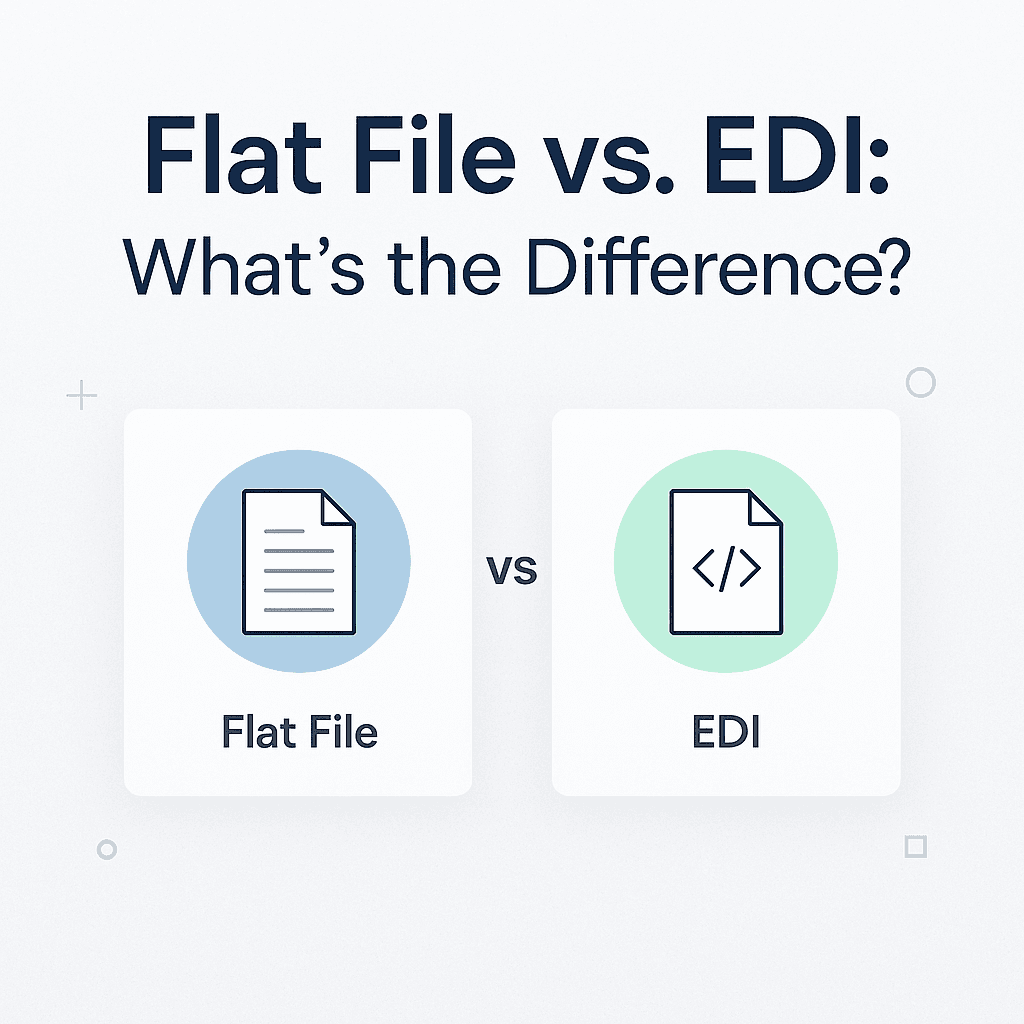Discover how modern retail EDI keeps suppliers compliant with big-box requirements while improving accuracy and trust across the entire supply chain.
When you exchange business data, two terms probably come to mind: flat file and electronic data interchange, or EDI. Both file types move information between systems, and they often look similar at a glance. That overlap can create confusion, especially when you're trying to understand which format is right for your supply chain operations.
The distinction matters, and knowing the difference puts you on the right path for exchanging business documents with speed, accuracy, and scalability. This article will help you understand where flat files fit into the picture and why EDI remains the industry standard.
Why People Confuse Flat Files With EDI
Flat files and EDI documents are often mistaken for the same thing because both are used to exchange data between computer systems. Even at a surface level, they can look alike, with rows of text, columns of values, and data fields arranged in a predictable sequence.
The difference is that flat files are simply a way to structure information in plain text, while EDI relies on standards created by organizations such as the American National Standards Institute (ANSI X12 standards) or set by the United Nations Economic Commission for Europe (EDIFACT standards). This means a flat file can carry the same data as an EDI file, but that doesn't make the file itself a standardized EDI document. Confusion often arises because many businesses use the term “EDI flat file” when describing raw or unmapped data before it has been validated against official EDI standards.
What Is a Flat File?
A flat file is a plain text file that stores information in a simple, two-dimensional structure. Data is usually separated by delimiters such as commas, tabs, or vertical lines, creating rows and columns that different computer systems can easily read. Common examples include CSV files, XML files, and even Excel spreadsheets saved in text-based formats. Because the layout is straightforward, flat files are easy to create, edit, and share across systems. Some organizations continue using flat files because they're familiar and easy to set up. However, these files carry additional risks, including a higher potential for errors and increased EDI costs over time.
Flat files are often used for basic data exchange in legacy systems, reporting, or internal transfers. They're flexible, but they lack the validation and rules that structured EDI requires. In cases where businesses make a reference to an EDI flat file, they're usually talking about a raw or unmapped version of an EDI document. The flat file format may contain the right data elements, but until it's validated against EDI standards, it isn't considered a true EDI file. That distinction is key to understanding why the two file types are not interchangeable.
What Is EDI?
Electronic data interchange (EDI) is a standardized way for computer systems to exchange business documents. Instead of passing information in a loose, text-based format, EDI organizes data into structured rules that ensure interoperability between trading partners. It’s designed to replace manual processes with computerized transactions, giving you a faster and more reliable way to exchange business data.
The most common EDI standards are published by the American National Standards Institute (ANSI) in North America and by the United Nations Economic Commission for Europe (UNECE) internationally. These standards define how purchase orders, shipping notices, invoices, and other documents should be formatted so that every trading partner reads the EDI data the same way. By following a standard format, you'll see improved compliance, reduced errors, and streamlined business processes.
Flat File vs. EDI: Key Differences
Although flat files and EDI files can both exchange data, their structure and validation methods make them very different tools. A flat file is flexible but unstandardized, whereas EDI transactions are rigidly defined to ensure they operate consistently between business partners. The table below highlights the most important differences.
Feature | Flat Files | EDI Files |
Structure | Simple rows and columns, plain text, variable flat files allowed | Structured EDI with a hierarchical format and strict data elements |
Standards | No universal standards; CSV, TXT, XML, or Excel formats | Governed by EDI standards like ANSI X12 and UN/EDIFACT |
Compliance | Not recognized as an official file format for trading partners | Required by retailers, logistics providers, and other business partners |
Scalability | Works for small exchanges but requires manual oversight | Automates high-volume data exchange and scales across supply chains |
Error Handling | Errors are harder to detect; no built-in validation | Built-in validation ensures documents meet requirements |
Some companies even frame the question as EDI vs. CSV or EDI vs. XML, but these aren’t really separate debates. CSV and XML are just examples of flat file formats, while EDI is a standardized method for exchanging entire documents. Flat files are simply containers for data, while EDI defines the rules that make that data usable across trading partners.
If you're looking to expand beyond simple file formats, ERP/EDI integration strategies can help bridge the gap between internal systems and partner requirements.
Where Flat Files Fit in Modern Workflows
Even though simple flat files aren’t standardized, they still play a role in many business processes. Small trading partners sometimes exchange CSV or XML files when neither side requires full EDI compliance.
Flat files are also used as an intermediate step in EDI translation software, where a plain text file is created before being converted into structured EDI file formats. These uses make flat files a convenient option for quick, lightweight data exchange.
For example, a regional supplier might trade flat files with a local retailer to send basic order details or shipping information. This setup works when volumes are low and both sides are comfortable with a simple format, but it can become risky as data flow increases.
Relying too heavily on flat files may eventually lead to compliance issues and avoidable expenses, especially as you take on new trading partners. Implementing EDI aligns processes and ensures compatibility across your supply chain.
Why Enterprises Rely on EDI Standards
Enterprises depend on electronic data interchange because it creates consistency and reliability across their trading networks. Retailers, healthcare providers, and logistics companies often require their partners to exchange purchase orders, shipping notices, invoices, and other records in structured EDI formats. Without these standards, managing large volumes of transactions would be nearly impossible.
Key reasons enterprises rely on EDI standards include:
Mandated compliance: Large retailers and distributors often require EDI for exchanging business and commercial documents. Failure to comply can result in financial penalties such as chargebacks or even lost connections to trading partners.
Interoperability across trading partners: Establishing strict standards ensures that documents can be shared consistently across industries and regions.
Efficiency and automation: EDI replaces manual entry with computerized transactions, streamlining processes and reducing errors.
Inventory visibility: Many manufacturers and distributors use EDI for vendor-managed inventory, which requires accurate and timely data exchange.
These benefits extend beyond meeting current requirements. EDI standards make it easier to grow your operations, add new trading partners, and expand into global markets without rebuilding your processes entirely from scratch. That future-proofing positions EDI as the backbone of modern supply chains.
How Hybrid and Modern EDI Solutions Bridge the Gap
While flat files still appear in many workflows, they’re not enough if you need to scale or meet strict partner requirements. A modern EDI implementation solves this by acting as a bridge between legacy systems and standardized EDI. They can accept flat file formats and convert that information into structured EDI documents that comply with partner standards.
Today’s API-first platforms and web EDI tools expand those capabilities even further. Instead of relying on manual file transfers or batch uploads, you can integrate application programming interfaces (APIs) to connect existing systems directly to your EDI network. This enables faster and more flexible data flows that integrate seamlessly with other enterprise applications.
Tools that streamline EDI onboarding let your system exchange documents quickly, without the delays and complexity that come with legacy EDI systems. This combination of flexibility and speed makes hybrid approaches valuable for modernizing your supply chains.
Choose the Right Path: Flat File vs. EDI
Flat files have their place in business, but they aren’t designed for the consistency and growth that today’s supply chains demand.
EDI processes offer a standardized method for exchanging documents across entire trading networks, enabling interoperability with trading partners across retail, ecommerce, and logistics environments. If you want to stay competitive, adopting EDI is the clear path forward.
As more trading partners mandate compliance, updating sooner to a modern EDI solution helps your organization avoid obstacles and costly rework that come with sticking with outdated file formats. If you're weighing your options, explore solutions built for both speed and scalability. Speak to an EDI expert today and discover how modern platforms can help you move beyond flat files and unlock smarter supply chain integration.
EDI Flat File FAQs
What is a flat file in business?
A flat file is a plain text file that stores information in a simple, two-dimensional structure using delimiters such as commas, tabs, or vertical bars. Examples include CSV and XML files. Flat files are flexible and easy to create but lack the validation and rules of standardized EDI formats.
What is an EDI file?
An EDI file is a structured business document formatted according to global standards such as ANSI X12 or UN/EDIFACT. EDI files are used by companies to exchange purchase orders, invoices, and shipment notices automatically with their trading partners.
Why do people confuse flat files with EDI?
People often confuse flat files with EDI because both are text-based and appear similar at a glance. However, a flat file is just a container for data, while EDI defines strict rules and validation to ensure documents are compliant and interoperable across trading partners.
Can a flat file be used as EDI?
A flat file can contain the same information as an EDI file, but until it is validated and converted into a standardized format, it is not considered true EDI. Many businesses use the term “EDI flat file” to describe raw data before it’s transformed into compliant EDI documents.
What are the advantages of EDI over flat files?
EDI provides standardized, automated, and scalable data exchange. Benefits include faster partner onboarding, fewer errors, built-in compliance with partner requirements, and the ability to handle large transaction volumes across complex supply chains.
Do companies still use flat files today?
Yes, some smaller businesses and legacy systems still use flat files like CSVs for lightweight data exchange or internal reporting. However, reliance on flat files can become a liability as transaction volumes grow and trading partners demand compliance with EDI standards.
- 01Why People Confuse Flat Files With EDI
- 02What Is a Flat File?
- 03What Is EDI?
- 04Flat File vs. EDI: Key Differences
- 05Where Flat Files Fit in Modern Workflows
- 06Why Enterprises Rely on EDI Standards
- 07How Hybrid and Modern EDI Solutions Bridge the Gap
- 08Choose the Right Path: Flat File vs. EDI
- 09EDI Flat File FAQs

